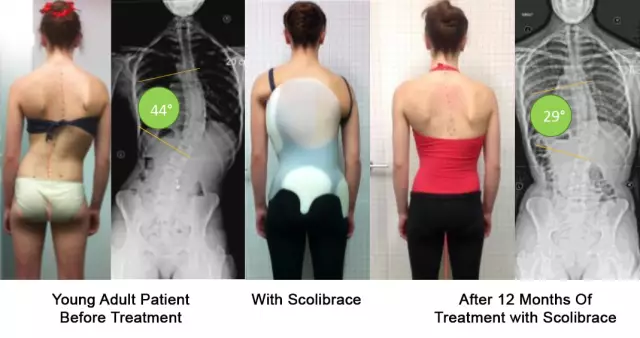- Author Curtis Blomfield [email protected].
- Public 2023-12-16 20:44.
- Last modified 2025-01-23 17:01.
Inflammation of the spine, or as it is also called, spondylitis, is a whole set of diseases. It is important to know that the human spine is a kind of support rod that holds the entire skeleton on itself. Inflammatory processes in it can develop for various reasons.

The core of the problem
Pathology can be the result of an infectious disease, certain types of injuries, tumors, develop with damage to internal organs, as well as intoxication. In the future, inflammation of the spine is accompanied by deformative processes, which can lead to the destruction of the vertebrae. That is why it is important to notice the problem in time and start competent treatment.
What is a disease?
The way the disease will proceed is directly affected by its type and the cause of the development of the pathology. For example, the disease of an infectious disease is reactive, acute. The inflammatory process of the aseptic type develops mainly gradually. However, at firststages, the clinical picture of these two types of pathology is similar. Basically, inflammation of the spine is manifested by painful sensations, numbness of the limbs or certain parts of the body, a feeling of stiffness. How intensively the symptoms will develop depends on the stage and characteristics of the course of the pathology.
Inflammation of the spine is of two types: infectious and aseptic.

The difference between the aseptic type and the infectious type
- Inflammation of the infectious type. Due to the anatomical arrangement of the spinal column, harmful bacteria can easily enter it. Therefore, virtually any infection can lead to detrimental consequences. In the spine, the infection penetrates from other organs, transported through the blood. Another way of infection is the lack of sterility during surgery.
- Aseptic type inflammation. This is an inflammatory process that occurs regardless of the infection. This type of pathology can also be divided into autoimmune and degenerative-dystrophic diseases. The latter leads to deformation of the intervertebral discs, which leads to clamping of the nervous and other tissues. Since the intervertebral discs cannot fully support the bony bodies of the vertebrae, they gradually wear out. As a result of this and some other factors, an inflammatory process develops. Speaking of autoimmune pathology, it is worth saying that in this situation the body fights its own cells with the help of leukocytes on its own. So, with Bakhterev's disease, in an organism thatcontains a special gene, after an infectious infection, the immune system begins to perceive the cartilaginous tissues of the discs as an infection, and they are destroyed, replaced by bone tissue. This leads to limited motor activity of the spine, pain and inflammation.
Inflammation occurs in approximately 0.4-1.4% of spinal diseases. This pathology is typical mainly for adolescents and young people, but in people of a more mature age, this problem is extremely rare. In men, the inflammatory process develops 3 times more often than in women.

Causes of violation
Factors affecting the development of the inflammatory process in the spine are usually classified into several types:
- Specific - associated with the entry into the body of a special bacterium that provokes specific, characteristic only for her changes in the vertebrae.
- Non-specific - provoke the typical development of a disease similar to purulent inflammation. The cause of this course of pathology can be various opportunistic intestinal bacteria, staphylococci, etc.
- Rheumatoid are inflammations of the aseptic type, which occur as a result of an erroneous attack of the cells of the vertebrae by the body's antibodies. In this situation, heredity is very important, which plays a big role in the functioning of the immune system.
In addition to the above factors, inflammation is influenced by prolonged weakening of the immune system (especially after a course of treatment with somedrugs), spinal injuries, chronic specific infectious diseases (tuberculosis, gonorrhea, etc.).
Consequences of pathology
Inflammatory processes in the spine can lead to serious complications. In particular, fistulas, kyphotic and other types of deformities, abscesses, neurological problems can form. Also, pathology provokes restrictions on motor activity and destruction of vertebral tissues.

Clinical presentation and diagnostic measures
Signs of almost all types of inflammation are not particularly different and depend on the stage and severity of the pathology. The infection enters the vertebra itself or into the arches with processes, multiplies there and leads to the destruction of bone tissue. Subsequently, dead sections of the spine are separated and compress the spinal cord or roots. An edematous process may develop in the central spinal canal, which leads to neurological disorders. In addition, inflammation of the spinal nerves can occur, leading to meningitis.
Neurological problems
Neurological he alth problems vary by location of inflammation:
- Serious symptoms are observed with inflammation of the cervical spine. There is a risk of complete or partial paralysis of the limbs, a decrease or complete loss of sensitivity below the zone of the affected vertebra, problems associated with involuntary urination and fecal incontinence.
- Similar clinic althe picture is present with inflammation of the thoracic spine. The only difference is that disturbances in motor activity are observed only in the region of the lower extremities and are of a spastic nature. Other symptoms are identical, only the painful sensations are of the shingles type.
- Disturbances in inflammation of the lumbar spine are characteristic symptoms. There are mildly pronounced paralysis of the lower extremities, in some cases involuntary urination and defecation, pain in the legs, which are given to the perineum. The pain is usually stabbing in nature and sometimes seems to shoot through. Sometimes the temperature may rise, dizziness, weakness appear. This is a sign of intoxication in the body.
Regardless of the type of disease, whether it is inflammation in the joints, spine or root disorders, it is imperative to undergo an examination at a medical institution. Diagnostic measures are reduced to examination and some general clinical studies. In particular, an x-ray is prescribed, and in especially difficult cases, an MRI (magnetic resonance imaging) or MCT (multispiral computed tomography).

Treatment of disease
Treatment of inflammatory processes in the spine should be comprehensive and consist of the following important steps:
- special diet and special motor regimen;
- course of drug therapy;
- physical therapy.
Medic altreatment
Medicated, symptomatic treatment of spinal inflammation is based on three components:
- Etiological treatment. It consists in the elimination of the factor provoking the disease. In this case, antibacterial drugs are prescribed. With the fungal nature of the disease, it is necessary to take antifungal medications, in particular, Itraconazole. With inflammation of the aseptic type, etiological treatment is not needed.
- Pathogenetic treatment. It consists in the destruction of the chain of pathological reactions. Non-steroidal anti-inflammatory drugs are aimed at eliminating inflammatory processes. These include "Revkoksikam", "Diclofenac" and others. In a more severe course of the disease, hormonal agents can be prescribed - glucocotic steroids, which effectively eliminate inflammatory processes and are used in autoimmune diseases. It is important to know that such drugs have many side effects, so it is strictly forbidden to take them without the appointment and supervision of a specialist.
- Symptomatic treatment. Designed to eliminate unpleasant symptoms and improve the general well-being of the patient. Painkillers are used, for example, Ibuprofen, Ketanol. They can also minimize the side effect of other medications.
In some cases, you have to resort to surgery. So, with inflammation of a hernia of the spine and similar diseases, it may be necessary to eliminate the problem by a surgeon.
Also, the operation can be assigned then,when conservative methods of treatment do not work, or the symptoms do not disappear for a long time. An important stage of treatment is a special motor mode. Depending on the type of pathology and its course, the doctor may recommend a special therapeutic physical education complex (LFK) or therapeutic massage. Various physiotherapy treatments may also be prescribed.
If the disease is not complicated, home treatment can be prescribed, which is reduced to medications and some physical exercises. Sometimes a specific diet may be recommended.

Prevention measures
The following recommendations are given as preventive measures:
- Important to strengthen the immune system to eliminate the risk of infectious inflammation of the spine.
- Be sure to move a lot and play sports, however, without excessive loads and stress.
- Food plays a big role. The diet must be balanced. If you have problems with excess weight, you need to carefully monitor nutrition, because excess weight increases the load on the spine.
- Try to protect your spine from injury.
- When sedentary, take regular breaks and exercise.
- Regularly and timely undergo body examinations to prevent the occurrence and development of infections that provoke the inflammatory process.

Forecast
With timely and effectivetreatment, the disease does not pose any threat, because it can be cured in the initial stages. In the event that complications and neurological problems begin, the therapy will require more time and more complex methods. However, following all the recommendations of the doctor will help to achieve positive results. At the first suspicion of inflammation of the roots of the spine or any other parts of it, you should seek help from a specialist as soon as possible.






